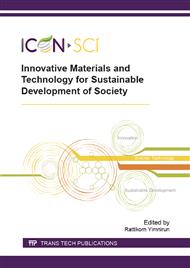[1]
Cz. Koepke, K. Wisniewski, M. Grinberg, G.H. Beall, Excited State Absorption in the Gahnite Glass Ceramics and Its Parent Glass Doped with Chromium, Spectrochim. Acta. Part A 54 (1998) 1725-1734.
DOI: 10.1016/s1386-1425(98)00104-8
Google Scholar
[2]
B. Kusz, K. Trzebiatowski, R.J. Barczynski, Ion Conductivity of Bismuth Silicate and Bismuth Germanate Glasses, Solid State Ionics 159 (2003) 293-299.
DOI: 10.1016/s0167-2738(02)00911-6
Google Scholar
[3]
A.V. Deshpande, V.K. Deshpande, Correlation of Glass Transition Temperature and Density with Electrical Conductivity of Lithium Sulfoborosilicate Glasses, Solid State Ionics 177 (2006) 2747-2751.
DOI: 10.1016/j.ssi.2006.07.021
Google Scholar
[4]
A.A. Ali, M.H. Shaaban, Electrical Conductivity of Silver Bismuth Borate Tellurite Glasses, Phys. B 403 (2008) 2461-2467.
DOI: 10.1016/j.physb.2008.01.005
Google Scholar
[5]
G.F. Imbusch, Luminescence and Fluorescence Line Narrowing of Doped Glasses, Physica Scripta T 19B (1987) 354-359.
DOI: 10.1088/0031-8949/1987/t19b/006
Google Scholar
[6]
M. Prashant Kumar, T. Sankarappa, B. Vijaya Kumar, N. Nagaraja, Dielectric Relaxation Studies in Transition Metal Ions Doped Tellurite Glasses, Solid State Sci. 11 (2009) 214-218.
DOI: 10.1016/j.solidstatesciences.2008.05.015
Google Scholar
[7]
N. Musahwar, M.A. Majeed Khan, M. Husain, M. Zulfequar, Optical Properties of Selenium–tellurium Nanostructured Thin Film Grown by Thermal Evaporation, Physica B 404 (2009) 2134-2137.
DOI: 10.1016/j.physb.2009.03.049
Google Scholar
[8]
M. Haouari, M. Ajroud, H. Ben Ouada, H. Maaref, A. Brenier, and C. Garapon, Spectroscopic Properties of Cr3+-Doped Phosphate Glasses, Phys. Stat. Sol. 215 (1999) 1165-1177.
DOI: 10.1002/(sici)1521-3951(199910)215:2<1165::aid-pssb1165>3.0.co;2-q
Google Scholar
[9]
V.C. Costa, F.S. Lameiras, M.V.B. Pinheiro, D.F. Sousa, L.A.O. Nunes, Y.R. Shen, K.L. Bray, Laser Spectroscopy and Electron Paramagnetic Resonance of Cr3+ Doped Silicate Glasses, J. Non-Cryst. Soli. 273 (2000) 209-214.
DOI: 10.1016/s0022-3093(00)00170-8
Google Scholar
[10]
M. Rezvani, B. Eftekhari-Yekta, M. Solati-Hashjin, V.K. Marghussian, Effect of Cr2O3, Fe2O3 and TiO2 Nucleants on the Crystallization Behaviour of of SiO2-Al2O3-CaO-MgO(R2O) Glass-ceramics, Ceram. Int. 31 (2005) 75-80.
DOI: 10.1016/j.ceramint.2004.03.037
Google Scholar
[11]
F. El-Diasty, F.A. Abdel, Optical Band Gap Studies on Lithium Aluminum Silicate Glasses Doped with Cr3+ Ions, J. Appl. Phys. 100 (2006) 093511.
DOI: 10.1063/1.2362926
Google Scholar
[12]
H. El Batal Fatma, Gamma Ray Interaction with Bismuth Silicate Glasses, Nucl. Instrum. Methods Phys. Res., Sect. B 254 (2007) 243-253.
Google Scholar
[13]
K Won-in, J. Dutchaneephet, S. Pongkrapan, N. Sirikulrat, P. Dararutana, Analysis of Barium-bearing Glass Doped with Chromium Oxide, Mater. Sci. Forum 663-665 (2011) 943-946.
DOI: 10.4028/www.scientific.net/msf.663-665.943
Google Scholar


